
The Topics | Home
17
TRIGONOMETRIC FUNCTIONS OF ANY ANGLE
The corresponding acute angle
The main theorem
Polar coördinates
Proof of the main theorem
HOW SHALL WE EVALUATE tan 118°, for example? We will see that we will be referred back to an acute angle.
The corresponding acute angle
Let θ be an angle that terminates in any quadrant. Then by the corresponding acute angle, we mean the shortest angular distance to the x-axis.
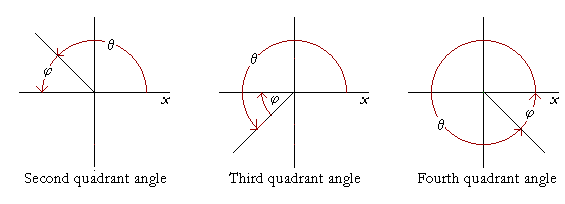
In each quadrant, φ is the corresponding acute angle. It is the shortest angular distance to the x-axis.
Examples.
If θ = 120° (Second quadrant), then φ = 60°.
If θ = 190° (Third quadrant), then φ = 10°.
If θ = 340° (Fourth quadrant), then φ = 20°.
Problem 1. Name the corresponding acute angle.
To see the answer, pass your mouse over the colored area.
To cover the answer again, click "Refresh" ("Reload").
a) 110°
70°
b) 225°
45°
c) −30°
30°
How, then, do we evaluate a function of any angle? According to the following theorem:
A function of any angle will equal plus or minus that same function
of the corresponding acute angle.
The sign will depend on the quadrant.
(We will prove that below.)
Example 1. Evaluate tan 120°.
Answer. The corresponding acute angle of 120° is 60°. Therefore, according to the theorem,
tan 120° = ±tan 60° = ±
Now in the second quadrant, tan θ (y/x) is negative (Topic 16). Therefore,
tan 120° = −
Example 2. Evaluate cos 195°.
Answer. The corresponding acute angle of 195° (third quadrant) is 15°. Therefore,
cos 195° = ±cos 15° = ± .966, from the Table.
In the third quadrant, cos θ (x/r) is negative. Therefore,
cos 195° = − .966
Example 3. Evaluate sec (−45°).
Answer. The corresponding acute angle of −45° (fourth quadrant) is 45°. Therefore,
sec 45° = ±sec 45° = ±
In the fourth quadrant, sec θ (r/x) is positive. Therefore,
sec 45° = 
Problem 2. Draw a figure that illustrates the following.
The sine of an obtuse angle is equal to the sine of its supplement.
The cosine of an obtuse angle is equal to the negative of the cosine
of its supplement.

The supplement, 180° − θ, is the corresponding acute angle!
Problem 3. Evaluate each of the following. No tables.
a) sin 150°
The corresponding acute angle is 30°. And in the second quadrant, sin θ is positive. Therefore, sin 150° = sin 30° = ½.
b) cos 135°
The corresponding acute angle is 45°. And in the second quadrant, cos θ is negative. Therefore, cos 135° = −cos 45° = −½ . .
c) tan 240°
The corresponding acute angle is 60°. In the third quadrant, tan θ is positive. Therefore, tan 240° = tan 60° =  . .
d) csc (−30)°
The corresponding acute angle is 30°. In the fourth quadrant, csc θ (y/r) is negative. Therefore, csc (−30)° = −csc 30° = −2.
Problem 4. Use the Table to evaluate the following.
a) cos 170°
The corresponding acute angle is 10°. In the second quadrant, cos θ is negative. Therefore, cos 170° = −cos 10° = − .985.
b) cos (−20°)
The corresponding acute angle is 20°. In the fourth quadrant, cos θ is positive. Therefore, cos (−20°) = cos 20° = .940.
b) sin (−20°)
The corresponding acute angle is 20°. In the fourth quadrant, sin θ is negative. Therefore, sin (−20°) = −sin 20° = − .342.
In the previous problem, we see an extremely useful theorem:
| cos (−θ) = cos θ, but sin (−θ) = −sin θ.
|
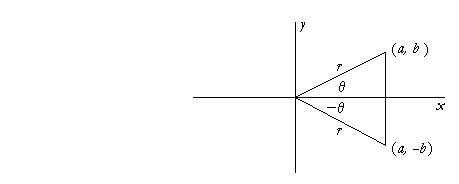
The figure shows: If θ terminates in the first quadrant at (a, b), then −θ will terminate at (a, −b). Therefore,
But
| sin (−θ) = − |
b
r |
= −sin θ. |
Problem 5. Use the previous theorem to evaluate the following. No tables.
a) cos (−30°)
= cos 30° =  /2 /2
b) cos (−60°)
= cos 60° = ½
c) cos (−45°)
= cos 45° = ½
d) sin (−30°)
= −sin 30° = −½.
e) sin (−60°)
= −sin 60° = − /2 /2
c) sin (−45°)
= −sin 45° = −½
Polar coördinates
We can specify the position of a point P by giving its distance r from the origin and the angle θ it makes with the x-axis. Those are called its polar coördinates.

But the polar coördinates are easily related to the rectangular coördinates (x, y). Since
then
And since
Example 4. A radius of 8 cm sweeps out an angle of 30° in standard position. What are the rectangular coordinates (x, y) of the endpoint of the radius?

| Answer. |
| x = r cos θ = 8 cos 30° = 8· |

2 |
= 4 |
y = r sin θ = 8 sin 30° = 8· ½ = 4
Problem 6. Radius AB of a unit circle sweeps out an angle 135°. What are the coordinates of B?
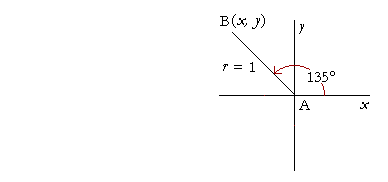
The corresponding acute angle of 135° is 45°. In the second quadrant, the cosine is negative and the sine is positive. Therefore, x = r cos θ = 1· cos 135° = −cos 45° = −½ . .
y = r sin θ = 1· sin 135° = sin 45° = ½ . .
Problem 7. Radius AB of length 2 sweeps out an angle of −60°. What are the coordinates of B?
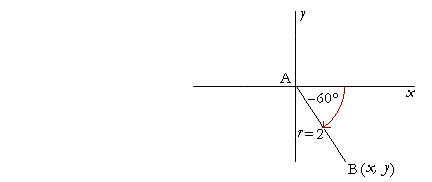
cos (−θ) = cos θ, but sin (−θ) = −sin θ.
Therefore, x = 2· cos (−60°) = 2· cos 60° = 2· ½ = 1.
y = 2· sin (−60°) = 2(−sin 60°) = 2(−½ ) = − ) = − . .
Proof of the main theorem
A function of any angle will equal plus or minus that same function
of the corresponding acute angle.
The sign will depend on the quadrant.

First, if θ is a second quadrant angle, then r will terminate at a point
(−a, b). The corresponding acute angle is φ, which is also shown in its first quadrant position. In the second quadrant,
while in the first quadrant,
Therefore the sine of θ is equal to the sine of the corresponding acute angle.
Similarly,
| cos θ |
= − |
a
r |
= |
−cos φ |
| tan θ |
= − |
b
a |
= |
−tan φ |
And so on, for the remaining functions, so that in every case, a function of θ is plus or minus that same function of φ.

Next, if θ is a third quadrant angle, so that r terminates at (−a, −b), then
| sin θ |
= − |
b
r |
= |
−sin φ |
| |
| cos θ |
= − |
a
r |
= |
−cos φ |
| tan θ |
= |
−b
−a |
= |
b
a |
= −tan φ |
And so on, so that again, each function of θ is plus or minus that same function of φ.
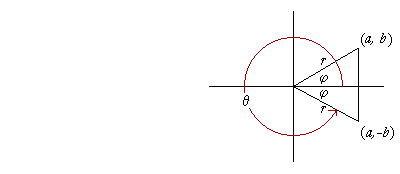
Finally, if θ is a fourth quadrant angle, so that r terminates at (a, −b), then
| sin θ |
= − |
b
r |
= |
−sin φ |
| |
| cos θ |
= |
a
r |
= |
cos φ |
| |
| tan θ |
= − |
b
a |
= |
−tan φ |
Therefore again, each function of θ is plus or minus that same function of the corresponding acute angle φ; which is what we wanted to prove.
Next Topic: Line Values
The Topics | Home
www.proyectosalonhogar.com
|